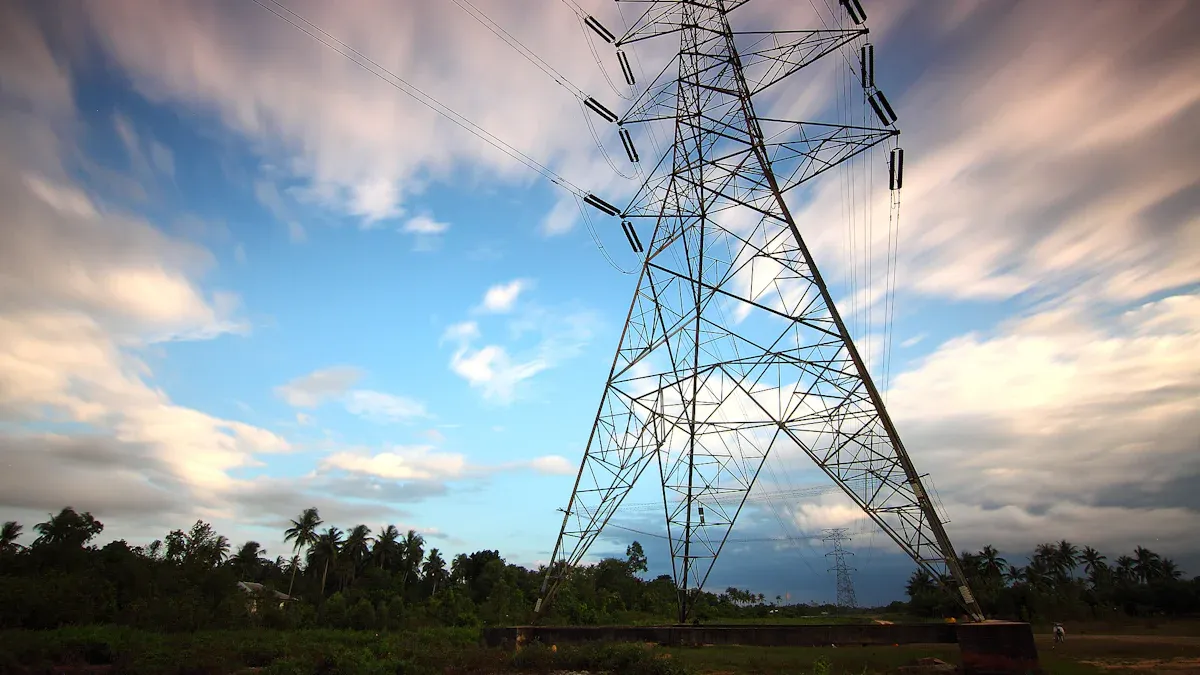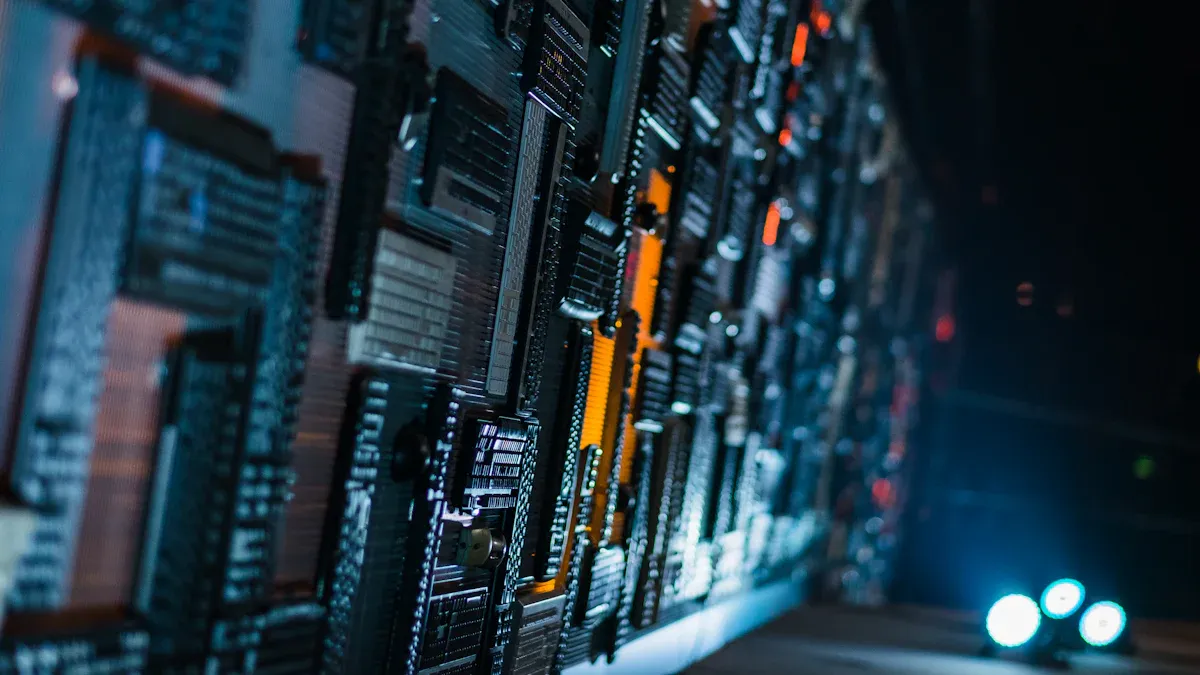The Science Behind ESTEL DC Rectifier Systems for Modern Power Applications

Modern energy systems rely on efficient and reliable technologies to meet growing demands. ESTEL DC rectifier systems play a pivotal role in this landscape by converting alternating current (AC) into direct current (DC) with precision. These systems ensure consistent power delivery while optimizing energy use. For example, ESTEL's innovations achieve energy conversion efficiencies as high as 91%, outperforming older technologies that struggled to reach 65%. With features like active power factor compensation and advanced protection mechanisms, ESTEL power rectifier systems empower you to maintain stable operations across diverse applications, from telecommunications to electric vehicle charging.
Key Takeaways
ESTEL DC rectifiers change AC power to DC power easily. They work at 98.5% efficiency, saving money on energy costs.
These systems use smart parts like diodes and control tools. This makes them reliable and good for important tasks.
Their modular design lets users add more parts as needed. This makes them useful for industries like phone networks and EV charging.
They have tools to check power and handle problems quickly. This keeps power running in places like hospitals and data centers.
ESTEL rectifiers help renewable energy by managing power flow better. They reduce energy waste and support a greener future.
Fundamentals of DC Rectifier Systems

What is a DC rectifier system?
A DC rectifier system is a device that converts alternating current (AC) into direct current (DC). This process is essential for powering electronic devices and systems that require a steady DC supply. Unlike AC, which alternates direction, DC flows in a single direction, making it ideal for applications like telecommunications, industrial machinery, and electric vehicle charging. At its core, the rectifier uses components like diodes to control the flow of current, ensuring that only one direction is allowed. This simple yet effective mechanism forms the backbone of modern power conversion technologies.
Components of a DC rectifier system
Every DC rectifier system consists of several key components that work together to achieve efficient power conversion. These include:
Diodes: These semiconductor devices allow current to flow in only one direction, making them the primary component in rectification.
Capacitors: These store electrical energy and help smooth out fluctuations in the DC output.
Inductors: These reduce ripple in the current, ensuring a more stable DC supply.
Transformers: These adjust the voltage level of the AC input before rectification.
Control Circuits: These manage the operation of the rectifier, optimizing performance and protecting against faults.
Together, these components ensure that the rectifier system delivers a reliable and stable DC output, even under varying load conditions.
The process of AC to DC conversion
The conversion of AC to DC involves several steps. First, the AC input passes through a transformer to adjust its voltage level. Next, the rectifier circuit, typically using diodes, converts the AC waveform into a unidirectional flow. Depending on the design, this can be achieved through half-wave or full-wave rectification.
Half-wave rectification uses a single diode to block one half of the AC waveform, resulting in a pulsating DC output.
Full-wave rectification employs multiple diodes or a bridge rectifier to utilize both halves of the AC waveform, producing a smoother DC output.
To further stabilize the output, capacitors and inductors are added to filter out ripples and ensure a steady voltage. Advanced systems may also include features like maximum power point tracking to optimize energy efficiency, especially in renewable energy applications. This entire process is critical for powering devices that rely on consistent DC energy.
The Science Behind ESTEL's Power Rectifier Systems
Advanced technologies in ESTEL rectifiers
ESTEL's rectifiers incorporate cutting-edge technologies that set them apart in the field of power conversion. One of the standout features is their use of advanced semiconductor materials in diodes, which significantly improve the efficiency and reliability of the rectification process. These diodes are designed to handle higher voltages and currents, ensuring stable performance even under demanding conditions.
Another key innovation is the integration of intelligent control systems. These systems monitor and adjust the rectifier's operation in real time, optimizing energy conversion and protecting against potential faults. For example, they can detect overloads or temperature fluctuations and take corrective actions instantly.
Additionally, ESTEL rectifiers feature modular designs that allow you to scale the system according to your power requirements. This flexibility makes them ideal for applications ranging from small-scale installations to large industrial setups.
Features enhancing energy conversion efficiency
ESTEL's power rectifier systems excel in energy conversion efficiency, thanks to their state-of-the-art design and engineering. These systems achieve efficiency rates as high as 98.5%, which is a significant improvement over conventional models. This high efficiency reduces energy losses, lowering operational costs and minimizing environmental impact.
The following table highlights how ESTEL rectifiers outperform traditional systems:
Feature | ESTEL Delta Rectifier Modules | Conventional Models |
|---|---|---|
Efficiency Rate | Up to 98.5% | Lower |
Operating Temperature Range | Up to 175°C | Limited |
Power Density | High | Standard |
Modular Design | Yes | No |
In addition to their efficiency, these rectifiers include features like thermal management and overload protection. These safeguards ensure stable voltage output, even in challenging environments. The modular design also enhances scalability, allowing you to expand or adjust the system as needed.
Advantages of ESTEL systems in modern applications
ESTEL's power rectifier systems offer numerous advantages that make them indispensable in modern applications. Their high efficiency and reliability ensure consistent power delivery, which is crucial for industries like telecommunications and data centers. These systems also support renewable energy integration by providing efficient DC–DC converter solutions that optimize the quality of energy conversion.
Another advantage is their ability to operate across a wide temperature range, up to 175°C. This capability makes them suitable for harsh environments where conventional systems might fail. The use of advanced diodes and intelligent control systems further enhances their performance, ensuring long-term reliability and reduced maintenance costs.
Moreover, ESTEL rectifiers contribute to sustainability by reducing energy waste and supporting green energy initiatives. Their modular design allows you to adapt the system to changing power demands, making them a future-proof solution for evolving energy needs.
Role of ESTEL DC Rectifier Systems in Energy Conversion
Applications in critical industries
ESTEL DC rectifier systems are indispensable in industries where reliable power is non-negotiable. You’ll find these systems in telecommunications, where they ensure uninterrupted communication by providing stable DC power to critical equipment. Data centers also rely on these rectifiers to maintain consistent energy flow, preventing downtime that could disrupt operations.
In the manufacturing sector, ESTEL rectifiers power industrial machinery, ensuring precision and efficiency in production lines. Their ability to handle high currents and voltages makes them suitable for heavy-duty applications. Additionally, the modular design of these systems allows you to scale them according to your specific needs, making them a versatile solution across various industries.
Benefits for renewable energy integration
Renewable energy sources like solar and wind generate power in variable forms, often requiring conversion to DC for storage or further use. ESTEL DC rectifier systems play a crucial role in this process. They ensure the quality of energy conversion by stabilizing the output and minimizing losses. For instance, when paired with a DC–DC converter, these systems optimize energy flow, making renewable energy integration more efficient.
One standout feature is maximum power point tracking, which adjusts the system to extract the highest possible energy from renewable sources. This capability not only enhances efficiency but also reduces waste, contributing to a more sustainable energy ecosystem. By using ESTEL rectifiers, you can seamlessly integrate renewable energy into existing power infrastructures, supporting global efforts toward cleaner energy solutions.
Ensuring reliability in power infrastructure
Reliability is a cornerstone of ESTEL DC rectifier systems. These systems incorporate advanced features like real-time monitoring, which provides insights into power consumption, temperature, and humidity. This data allows you to manage your power infrastructure more effectively. Compliance with industry standards ensures that these rectifiers meet stringent safety and performance benchmarks, giving you peace of mind.
Redundant power supplies in ESTEL systems guarantee uninterrupted power, even during outages or disruptions. This feature is critical in environments like hospitals and data centers, where downtime can have severe consequences. Regular maintenance and predictive technologies further enhance reliability, extending the lifespan of your equipment.
The following table highlights key reliability metrics of ESTEL systems:
Feature/Benefit | Description |
|---|---|
Real-time monitoring | Provides insights into power consumption, temperature, and humidity for better management. |
Energy efficiency | Optimizes energy usage, contributing to cost savings and reducing waste. |
Surge protection | Protects equipment from power abnormalities and overheating. |
Modular design | Allows for flexible power distribution tailored to specific needs in data centers. |
Reliable power backup | Ensures uninterrupted power supply, enhancing overall reliability. |
By leveraging these features, you can build a robust power infrastructure that meets the demands of modern applications while minimizing risks and inefficiencies.
Real-World Applications of ESTEL DC Rectifier Systems

Telecommunications and data centers
In telecommunications and data centers, maintaining a stable and efficient power supply is critical. ESTEL DC rectifier systems excel in these environments by delivering reliable DC power to essential equipment. Their robust design ensures uninterrupted operations, even in challenging conditions. For instance, the Three Bay Outdoor Cabinet Base Station is a versatile solution for outdoor applications. With dimensions of 2125mm x 1905mm x 750mm and a protection level of IP55, it withstands harsh weather while housing critical components like backup batteries and 19-inch or 23-inch equipment.
These rectifiers also optimize energy efficiency across varying discharge levels. At 80% discharge, system efficiency reaches 64%, while at 20% discharge, it drops to 36%. This performance highlights the importance of using advanced rectifier systems to minimize energy losses. By integrating features like intelligent control and thermal isolation, ESTEL rectifiers ensure consistent power delivery, reducing downtime and enhancing operational reliability.
Industrial and manufacturing sectors
In industrial and manufacturing settings, ESTEL DC rectifier systems provide the power needed to drive high-performance machinery. These systems support advanced equipment like the morbidelli ux200 drilling cell, which machines all six sides of a panel simultaneously, significantly reducing processing time. Similarly, the morbidelli cx210 drilling machine achieves a production rate of 350 pieces per shift, demonstrating the efficiency of ESTEL-powered operations.
The rectifiers' ability to handle high currents and voltages ensures seamless integration with complex manufacturing processes. Their modular design allows you to scale the system as production demands grow. Additionally, features like real-time monitoring and overload protection enhance safety and reliability, making ESTEL rectifiers an indispensable part of modern industrial infrastructure.
Electric vehicle charging systems
As electric vehicles (EVs) gain popularity, the demand for efficient charging infrastructure continues to rise. ESTEL DC rectifier systems play a pivotal role in meeting this demand. These systems convert AC power from the grid into DC power, which is essential for charging EV batteries. Their high efficiency minimizes energy losses, ensuring faster and more cost-effective charging.
The integration of a DC–DC converter further enhances the charging process by stabilizing the voltage and optimizing energy flow. This capability is particularly valuable in fast-charging stations, where consistent power delivery is crucial. With features like modular scalability and advanced thermal management, ESTEL rectifiers support the development of reliable and sustainable EV charging networks.
ESTEL DC rectifier systems represent a leap forward in power technology. Their advanced designs achieve efficiency rates above 95%, surpassing previous systems that struggled to reach 90%. You benefit from robust durability, modular maintenance, and cost-effective operation, making these systems ideal for modern applications.
Key Advantages:
High efficiency reduces energy losses and operational costs.
Fault-tolerant designs ensure reliability in critical environments.
Self-diagnostic systems provide real-time alerts for proactive management.
Feature | ESTEL Delta Rectifier Modules | Previous Systems |
|---|---|---|
Efficiency | Above 95% | Below 90% |
Cost-effectiveness | High long-term savings | Higher operational costs |
Durability | Robust designs for extreme conditions | Limited durability |
Maintenance | Modular, easy access | Complex, time-consuming |
By choosing ESTEL, you gain access to cutting-edge power solutions that redefine reliability and efficiency, ensuring your operations remain future-ready.
FAQ
What makes ESTEL DC rectifier systems more efficient than traditional models?
ESTEL systems use advanced semiconductor materials and intelligent control mechanisms. These innovations reduce energy losses and optimize power conversion. Efficiency rates reach up to 98.5%, surpassing older systems that struggled to achieve 90%. You benefit from lower operational costs and reduced environmental impact.
Can ESTEL rectifiers handle extreme environmental conditions?
Yes, ESTEL rectifiers operate reliably in temperatures up to 175°C. Their robust design includes thermal management features and surge protection. These systems perform well in harsh environments, ensuring uninterrupted power delivery for critical applications like telecommunications and industrial operations.
Are ESTEL rectifiers suitable for renewable energy systems?
Absolutely! ESTEL rectifiers integrate seamlessly with renewable energy setups. Features like maximum power point tracking optimize energy extraction from sources like solar panels. You can use them to stabilize output and minimize losses, making renewable energy integration more efficient and sustainable.
How do ESTEL systems ensure reliability in critical industries?
ESTEL rectifiers include real-time monitoring, redundant power supplies, and fault-tolerant designs. These features prevent downtime and protect equipment from power fluctuations. You gain peace of mind knowing your operations remain stable, even during outages or disruptions.
Can ESTEL rectifiers be customized for specific applications?
Yes, ESTEL systems feature modular designs that allow customization. You can scale the system to meet your power requirements, whether for small installations or large industrial setups. This flexibility ensures you get a tailored solution for your unique needs.
See Also
Ensuring Optimal Voltage Levels in ESTEL Communication Cabinets
Exploring ESTEL's Cooling Solutions for Industrial Cabinet Needs
Understanding the Power System of ESTEL Telecom Cabinets
Telecom Cabinet Energy Storage with ESTEL Smart Microgrid Integration
Calculating Power Systems and Batteries for Telecom Cabinets
CALL US DIRECTLY
86-13752765943
3A-8, SHUIWAN 1979 SQUARE (PHASE II), NO.111, TAIZI ROAD,SHUIWAN COMMUNITY, ZHAOSHANG STREET, NANSHAN DISTRICT, SHENZHEN, GUANGDONG, CHINA


